Accidents at work - statistics by economic activity
Data extracted in October 2023.
Planned update: October 2024.
Highlights
In 2021, the highest incidence of non-fatal accidents at work in the EU was observed in construction, with 3 152 such accidents per 100 000 persons employed.
In 2021, the highest incidence of fatal accidents at work in the EU was observed in mining and quarrying, with 7.2 such accidents per 100 000 persons employed.
Incidence rate of non-fatal accidents at work, EU, 2012–2021
This article presents a set of main statistical findings in relation to indicators concerning non-fatal and fatal accidents at work in the European Union (EU). The statistics presented have been collected as part of the European statistics on accidents at work (ESAW) administrative data collection exercise. This article analyses these statistics according to the type of economic activity in which accidents occur, focusing on selected activities: agriculture, forestry and fishing (NACE Section A); mining and quarrying (NACE Section B); manufacturing (NACE Section C); construction (NACE Section F); distributive trades (comprising wholesale, retail and motor trades, NACE Section G); transport and storage (NACE Section H); accommodation and food service activities (NACE Section I); administrative and support service activities (NACE Section N); public administration and defence (NACE Section O); and human health and social work activities (NACE Section Q).
Full article
Developments over time
Non-fatal accidents
In 2021, there were 2.9 million non-fatal accidents that resulted in at least four calendar days of absence from work in the EU (see Table 1). The total number of non-fatal accidents at work in the EU rose between 2012 and 2019, up some 203 000 (equivalent to an overall increase of 6.9 %). To some extent, this increase may reflect methodological changes in data collection/compilation in some of the EU Member States. For more information, please refer to the data sources section of the main article on accidents at work statistics. In 2020, this upward trend was interrupted, as the number of non-fatal accidents fell by 405 000, down 12.9 %. This change reflects, at least in part, the impact of the COVID-19 crisis on EU labour markets and working conditions. In 2021, there was a partial rebound in the number of non-fatal accidents, up 150 900 (equivalent to an increase of 5.5 %).
In absolute terms, non-fatal accidents in 2021, in the EU were most common in:
- manufacturing – 547 000 (19.0 % of the total);
- human health and social work activities – 384 000 (13.3 %);
- construction – 369 000 (12.8 %);
- distributive trades – 357 000 (12.4 %).
Given that the workforces of these activities vary greatly in size, the incidence rate (the number of non-fatal accidents at work for every 100 000 persons employed) gives a clearer impression of where workers were more likely to encounter non-fatal accidents.
In 2021, the highest incidence of non-fatal accidents at work in the EU was observed in construction, with 3 152 such accidents per 100 000 persons employed. Transport and storage (2 622 per 100 000) and administrative and support service activities (2 380 per 100 000) were the only other NACE sections with incidence rates above 2 000 per 100 000 persons employed. The lowest incidence rate among the selected activities was for public administration and defence (1 214 per 100 000 persons employed), as shown in Table 1.
There was an overall decrease in the EU’s incidence rate of non-fatal accidents between 2012 and 2019 (down 4.2 %), reflecting growth in the number of persons employed. Among the selected activities, incidence rates for non-fatal accidents at work were generally lower in 2019 than in 2012. This situation was observed for 8 out of the 10 NACE sections for which data are shown. Between 2012 and 2019 there were considerable increases in incidence rates for non-fatal accidents for public administration and defence (up 32.7 %) and human health and social work activities (up 12.3 %). Note that the changes observed for the EU in some activities may be linked to changes in coverage of specific activities for some EU Member States, for example because of the end of derogations or voluntary data collection.
Focusing just on the two latest annual changes, the incidence rate of non-fatal accidents fell 10.0 % between 2019 and 2020 (note that there is a break in series) and then increased 5.0 % between 2020 and 2021.
- A decrease in 2020 was observed for 8 out of the 10 NACE sections for which information is presented:
- the largest decrease was recorded for accommodation and food service activities, which had been particularly impacted in 2020 by restrictions imposed during the COVID-19 crisis, down 30.2 %;
- the only activities that recorded an increase in the incidence rate of non-fatal accidents in 2020 were agriculture, forestry and fishing (up 3.1 %) and human health and social work activities (up 17.7 %).
- An increase in 2021 was observed for 9 out of the 10 NACE sections for which information is presented:
- the largest increases were recorded for agriculture, forestry and fishing (up 18.6 %) and transport and storage (up 18.5 %);
- the only activity that recorded a decrease in the incidence rate of non-fatal accidents in 2021 was human health and social work activities (down 8.5 %).
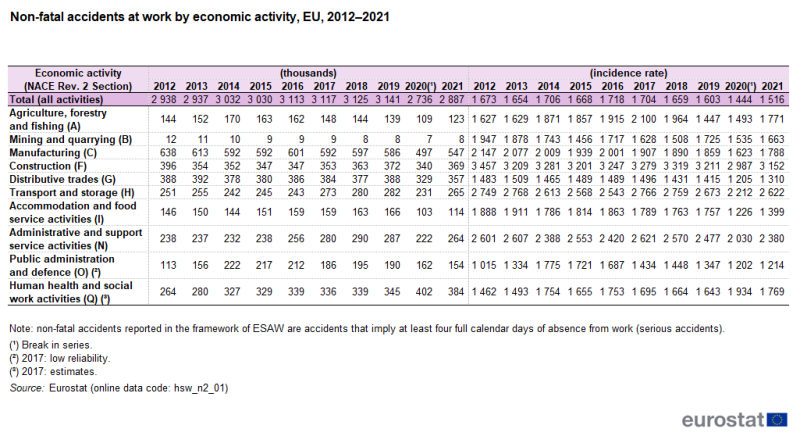
Source: Eurostat (hsw_n2_01)
Fatal accidents
In 2021, there were 3 347 fatal accidents at work in the EU (see Table 2), resulting in a ratio of 862 non-fatal accidents for every fatal accident. There was a decrease in the total number of fatal accidents at work in the EU between 2012 and 2019, some 349 fewer (equivalent to an overall decrease of 9.3 %). This decrease continued in 2020 and 2021: there were 50 fewer deaths in 2020 (note that there is a break in series) and 11 fewer in 2021, down 1.5 % and 0.3 %, respectively.
In absolute terms, fatal accidents in the EU were most common in 2021 in:
- construction, 741 (22.1 % of the total);
- transport and storage, 548 (16.4 %);
- manufacturing, 482 (14.4 %);
- agriculture, forestry and fishing, 382 (11.4 %);
- distributive trades, 322 (9.6 %).
In 2021, the highest incidence rate of fatal accidents at work (the number of fatal accidents at work for every 100 000 persons employed) in the EU was observed in mining and quarrying with 7.2 fatal accidents per 100 000 persons employed. Construction (6.3 per 100 000 persons employed), agriculture forestry and fishing (5.5 per 100 000) and transport and storage (5.4 per 100 000) were the only other NACE sections with incidence rates above 2.0 per 100 000 persons employed. Among the economic activities shown in Table 2, the lowest incidence rate was for human health and social work activities (0.5 per 100 000).
Across the EU, the decrease in the incidence rate of fatal accidents at work between 2012 and 2019 (down by 18.7 %) was somewhat greater than the decrease for the number of fatal accidents, reflecting growth in the number of persons employed. During the period 2012–2019, there was a larger reduction in the number of and incidence of fatal accidents at work than for non-fatal accidents. While incidence rates for fatal accidents at work – as for non-fatal accidents – were generally lower in 2019 than in 2012 for most activities, an increase was observed in the incidence rate for accommodation and food service activities (up 60.8 %).
Focusing on the two latest annual changes, the incidence rate of fatal accidents in the EU rose 1.7 % between 2019 and 2020 (note that there is a break in series) and then fell 0.6 % between 2020 and 2021. The increase in the incidence rate in 2020 was in contrast to the decrease in the number of fatal accidents, while in 2021 the number and incidence rate both fell slightly. In both years, there was a fairly even split among the NACE sections for which data are shown in Table 1 between those recording decreases and those recording increases.
- In 2020, decreases in the incidence rate were observed for construction, administrative and support service activities, accommodation and food service activities, and transport and storage. There was no change in the incidence rate of fatal accidents for manufacturing, with increases for all other economic activities shown. The largest increase was recorded for human health and social work activities, where the rate more than doubled (up 144.1 %).
- In 2021, relatively large decreases in the incidence rate were observed for human health and social work activities (down 42.2 %) and mining and quarrying (down 28.1 %). The largest increases were observed for distributive trades (up 14.6 %) and transport and storage (up 17.1 %).
Analysis of non-fatal accidents by sex and age
Accidents at work were more likely to involve men than women. In 2021, two out of every three (68.3 %) non-fatal accidents at work in the EU involved men (excluding cases where the sex of the victim experiencing the accident was not reported). To some extent, this reflects the fact that more men than women work in general and this difference is particularly strong in several activities with particularly high incidence rates. Another factor that influences gender differences is the different types of work that men and women carry out, even within a single activity.
The difference in incidence rates for men and women in construction was particularly large, with the rate for non-fatal accidents at work 7.1 times as high for men as for women. Similarly, the incidence rate for men was 5.7 times as high as for women in mining and quarrying. The only activity with a higher incidence rate for women than for men was human health and social work activities.
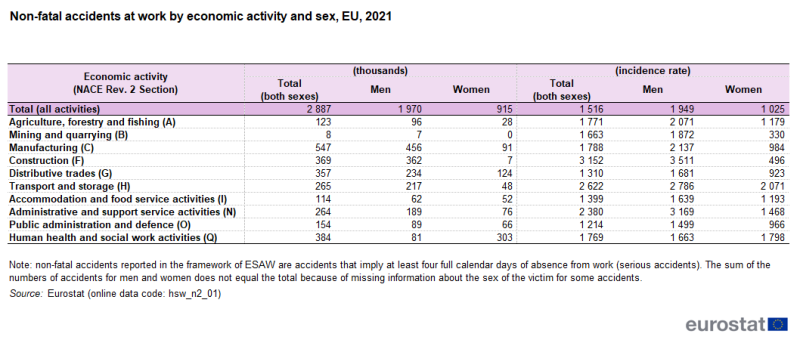
Source: Eurostat (hsw_n2_01)
Focusing on the 10 activities presented in Table 3, the four highest incidence rates for non-fatal accidents at work among women in the EU in 2021 were for transport and storage, human health and social work activities, administrative and support service activities, and accommodation and food service activities. For men, construction, administrative and support service activities, transport and storage, and manufacturing had the four highest rates (see Table 4).
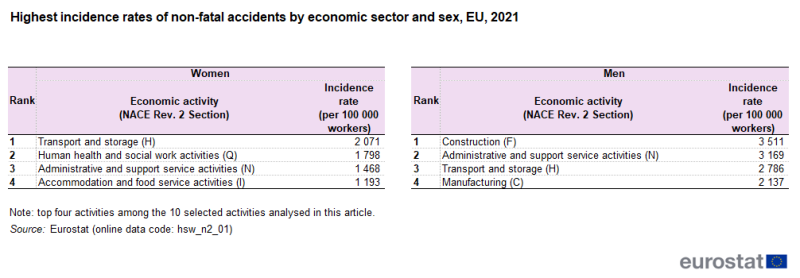
Source: Eurostat (hsw_n2_01)
Figure 1 helps to identify the activities where workers of a particular age range make up a greater or lesser share of those having suffered a non-fatal accident at work. It should be kept in mind that the age profile of the workforce may vary between economic activities.
Younger workers (those aged less than 25 years) accounted for 12.7 % of all non-fatal accidents at work in the EU in 2021. Higher (than the average for all economic activities) shares of non-fatal accidents among young workers were recorded in the following sectors:
- construction (14.5 %);
- administrative and support service activities (15.3 %);
- distributive trades (16.6 %);
- accommodation and food service activities (25.0 %).
Older workers (those aged 55 years and over) accounted for 19.2 % of all non-fatal accidents at work in the EU in 2021. Higher shares of non-fatal accidents among older workers were recorded for:
- transport and storage (19.9 %);
- human health and social work activities (23.0 %);
- public administration and defence (25.3 %);
- agriculture, forestry and fishing (26.6 %).
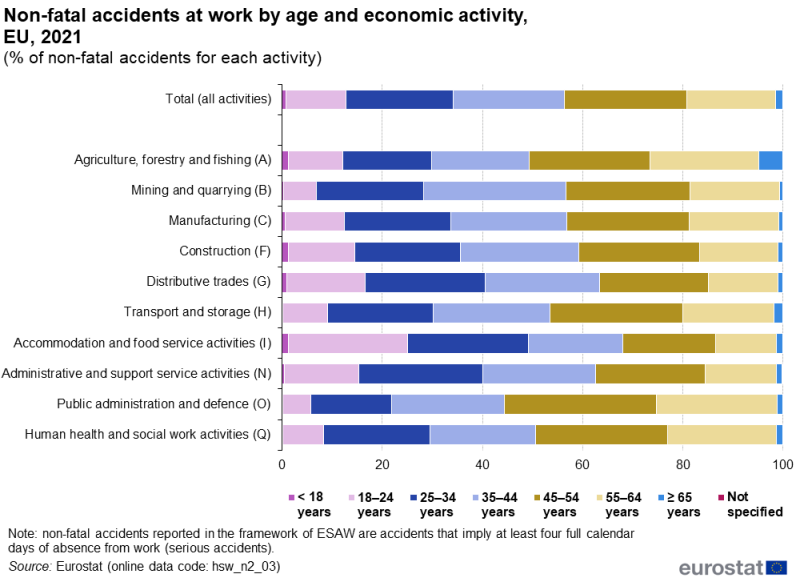
(% of non-fatal accidents for each activity)
Source: Eurostat (hsw_n2_03)
Severity of accidents
The data presented in Figure 2 include information for non-fatal and fatal accidents. This analysis identifies the number of calendar days (grouped into several classes) during which the victim was unfit for work, excluding the day of the accident itself, or whether there was a permanent incapacity or death (within one year of the accident) as a result of the accident at work.
In the EU, a considerable majority (86.1 %) of all accidents at work in 2021 involved the victim being unfit for work for less than three months, while some 10.6 % were for longer periods (or resulted in permanent incapacity) and 0.1 % were fatal accidents. For the remaining 3.2 % of cases, the severity (in terms of duration of being unfit for work) was unknown.
Accidents at work resulting in the victim being unfit for work for less than three months made up a relatively large proportion of accidents at work in the EU in 2021 in distributive trades (88.6 %), manufacturing (88.9 %) and accommodation and food service activities (89.6 %).
By contrast, the share of workplace accidents in the EU in 2021 that were non-fatal but resulted in the victim being unfit for work for three months or more made up a particularly large share of all workplace accidents for mining and quarrying (20.5 %), nearly twice as high as the average for all activities.
Fatal accidents accounted for 0.1 % of all workplace accidents in the EU in 2021. Among the selected activities, construction (0.2 %), transport and storage (also 0.2 %), agriculture, forestry and fishing (0.3 %), and mining and quarrying (0.4 %) had higher shares.
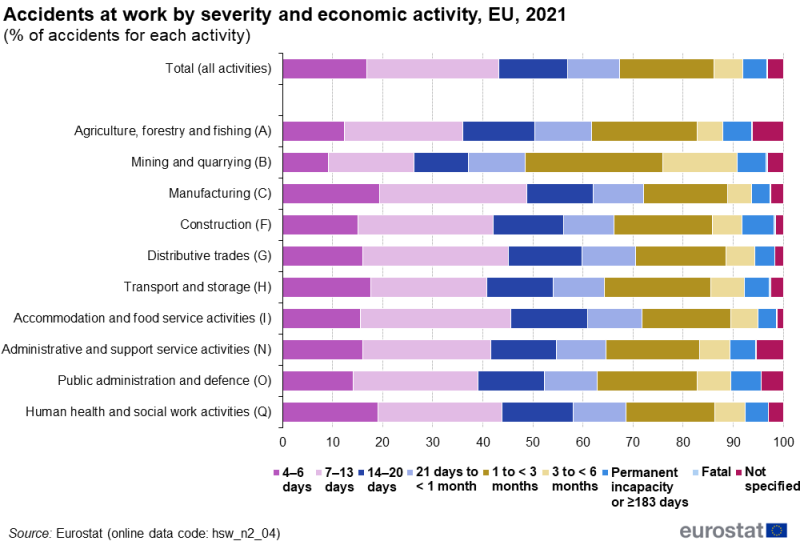
(% of accidents for each activity)
Source: Eurostat (hsw_n2_04)
Analysis by injured body part
The description of an accident at work includes information on the injured body part. The following options are available for recording the body part injured in an accident at work:
- head;
- neck;
- back;
- torso and organs;
- upper extremities;
- lower extremities;
- whole body and multiple sites;
- other parts of body injured;
- not specified.
Figures 3 and 4 present an analysis of the type of body part injured in non-fatal and fatal accidents.
Non-fatal accidents at work
For all activities combined, the most common body parts injured in non-fatal workplace accidents in the EU in 2021 were:
- the upper extremities (shoulders, arms and hands), with 38.3 % of the total number of non-fatal accidents at work;
- the lower extremities (hips, legs and feet) with 29.1 %.
The only other type of body part with a share that was more than one tenth of the total was the back, accounting for 10.8 % of all injuries.

Source: Eurostat (hsw_n2_06)
Looking into the injured body part for the individual economic activities analysed in this article (see Figure 3 and Table 5), in 2021 non-fatal accidents at work that resulted in injuries of the upper extremities were particularly common in the EU within manufacturing (52.2 % of all accidents) and the accommodation and food service activities (47.4 %), but were less common in transport and storage (27.3 %) and human health and social work (26.6 %). For injuries of the lower extremities, there was less variation by activity, with the highest shares for transport and storage (36.3 %) and agriculture, forestry and fishing (33.2 %) and the lowest shares for manufacturing (24.4 %) and human health and social work (23.1 %). Back injuries were relatively common within human health and social work activities (16.0 %) and public administration and defence (12.7 %), while manufacturing (7.5 %) and mining and quarrying (6.7 %) were the activities with the lowest shares.
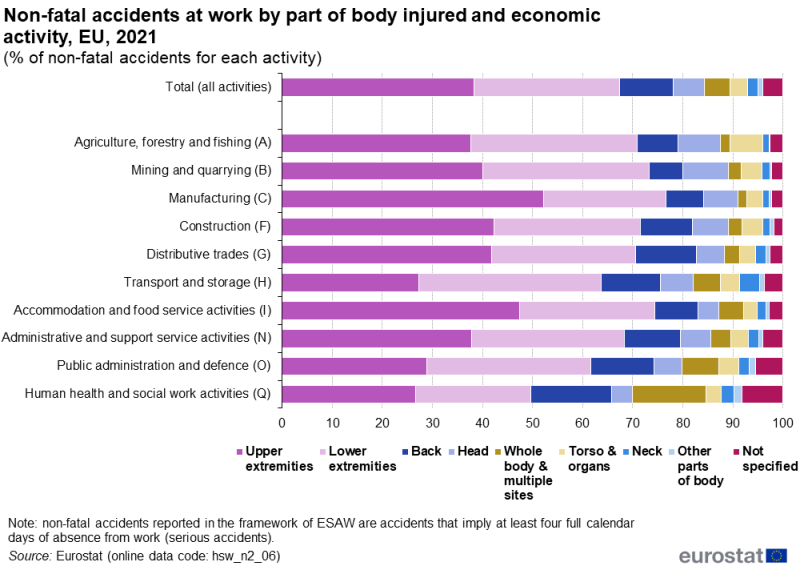
(% of non-fatal accidents for each activity)
Source: Eurostat (hsw_n2_06)
Fatal accidents at work
Turning to fatal accidents at work, the distribution by the body part that was injured was very different. For all activities combined, 3 in 10 fatal accidents in the EU in 2021 related to injuries of the whole body or multiple sites (30.8 %), while just over one fifth (21.9 %) were head injuries and 13.5 % were injuries to the torso and organs (see Figure 4).
The most common category of injuries in fatal accidents at work in the EU in 2021 concerned the whole body and multiple sites; this was observed for each of the 10 economic activities shown (when excluding the residual category of not specified). The highest share of fatal accidents at work concerning the whole body and multiple sites was recorded for mining and quarrying (45.5 %), while the lowest was for administrative and support service activities (23.7 %).
Looking at the less common body parts injured in fatal accidents at work, activities with relatively high shares included:
- mining and quarrying as well as distributive trades for upper extremities injuries;
- transport and storage as well as agriculture, forestry and fishing for neck injuries;
- mining and quarrying as well as manufacturing for injuries of the lower extremities;
- transport and storage for back injuries.
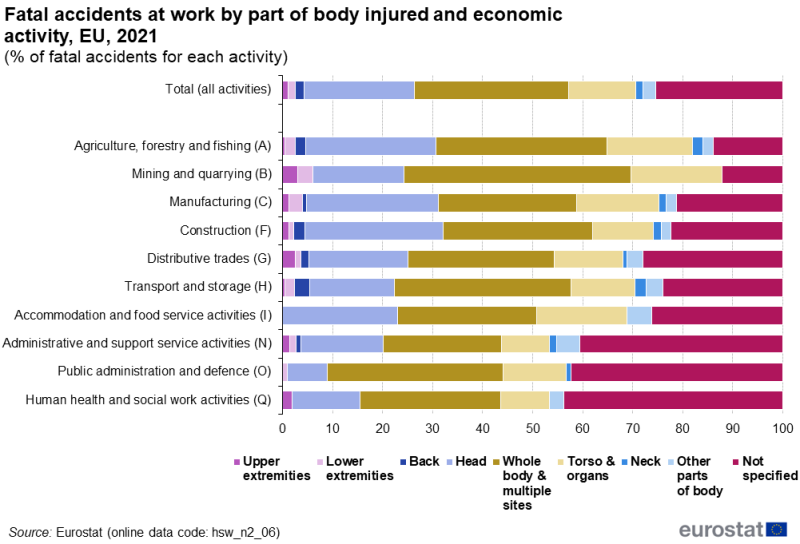
(% of fatal accidents for each activity)
Source: Eurostat (hsw_n2_06)
Analysis by type of injury
Figures 5 and 6 contain analyses of data according to the type of injury sustained when people were involved in accidents: note that the selected types of injury are similar but not identical in the two figures.
Non-fatal accidents at work
In 2021, the most common injuries in the EU resulting from non-fatal accidents were wounds and superficial injuries (28.0 % of the total), dislocations, sprains and strains (26.0 %), concussion and internal injuries (19.5 %), and bone fractures (11.1 %).
- Wounds and superficial injuries had the highest share of non-fatal accidents across 7 of the 10 economic activities shown in Figure 5.
- Dislocations, sprains and strains accounted for a higher share for transport and storage, human health and social work activities, and public administration and defence.
Looking at the less common types of injuries resulting from non-fatal workplace accidents, some were quite common in particular activities.
- Bone fractures were relatively common in mining and quarrying (19.1 %) as well as agriculture, forestry and fishing (17.9 %) compared with the average for all activities (11.1 %).
- The loss of body parts (amputations) was also relatively common in mining and quarrying (1.1 %), as well as manufacturing (0.9 %) and agriculture, forestry and fishing (0.8 %) compared with the overall average (0.4 %).
- Burns, scalds and frostbite were 3.9 times as common in accommodation and food service activities (5.7 %) as the average for all activities (1.5 %).
- Poisoning and infections were particularly common in human health and social work activities (15.3 %) and to a lesser extent in public administration and defence (4.9 %): these were the only two activities among those shown in Figure 5 with shares above the average for all activities (3.6 %).
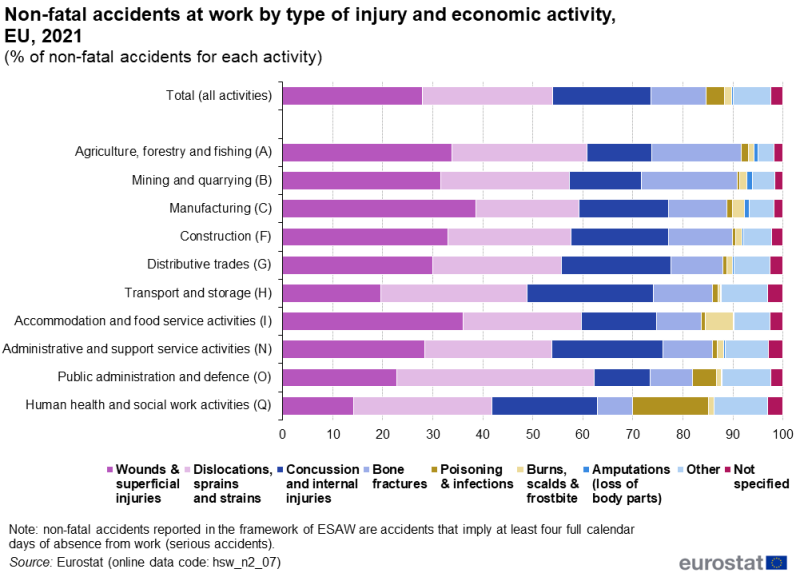
(% of non-fatal accidents for each activity)
Source: Eurostat (hsw_n2_07)
Fatal accidents at work
For fatal accidents at work in 2021, the most commonly observed injury types across the EU were concussion and internal injuries (21.8 % of fatal accidents) and multiple injuries (20.4 %), followed by bone fractures (9.1 %).
- Concussion and internal injuries were the most common type of injuries in 2021 for 5 of the 10 economic activities shown in Figure 6: agriculture, forestry and fishing, manufacturing, construction, distributive trades, and administrative and support service activities.
- Multiple injuries were the most common for mining and quarrying, transport and storage, and accommodation and food service activities.
- Bone fractures were relatively common for construction (13.2 %) and agriculture, forestry and fishing (11.3 %).
Less common types of injuries resulting from fatal workplace accidents included the following.
- Wounds and superficial injuries – these were relatively common within agriculture, forestry and fishing (10.5 % of fatal accidents), compared with the average for all activities (5.4 %).
- Poisoning and infections were the most common types of injuries resulting from fatal workplace accidents for public administration and defence as well as for human health and social work activities (both 27.9 %); the average for all activities was 5.3 %.
- Accidents involving drowning and asphyxiation – these were much more common than the overall average (2.4 %) for mining and quarrying (15.2 %), public administration and defence (6.3 %), and for agriculture, forestry and fishing (5.5 %).
- Burns, scalds and frostbite – these were much more common in mining and quarrying (6.1 %) and manufacturing (4.4 %) than they were across all activities (2.2 %).
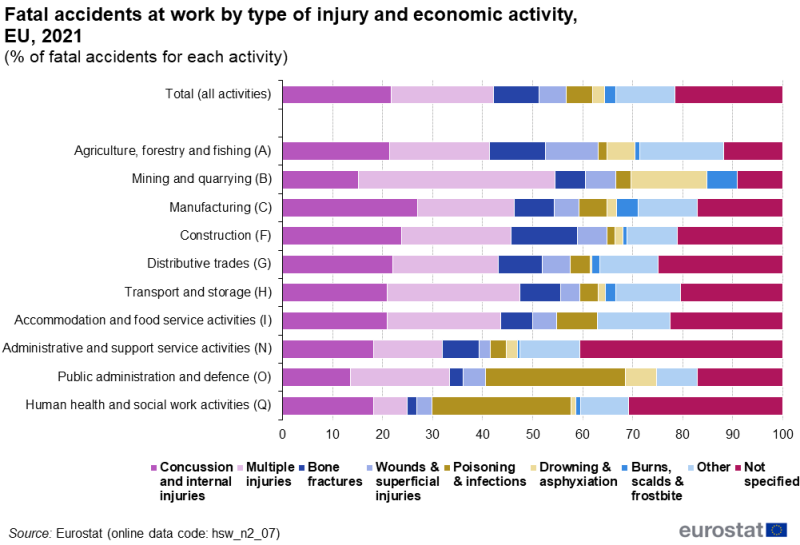
(% of fatal accidents for each activity)
Source: Eurostat (hsw_n2_07)
Source data for tables and graphs
Data sources
In December 2008, the European Parliament and the Council adopted Regulation (EC) No 1338/2008 on Community statistics on public health and health and safety at work. The Regulation is designed to ensure that health statistics provide adequate information for all EU Member States to monitor Community actions in the field of public health and health and safety at work. In April 2011, a European Commission Regulation (EU) No 349/2011 on statistics on accidents at work was adopted specifying in detail the variables, breakdowns and metadata that Member States are required to deliver – this legislation is being implemented in a number of phases. Note also that a Commission Decision No 2011/231/EU from April 2011 granted derogations to certain Member States with respect to the transmission of statistics on accidents at work.
European statistics on accidents at work (ESAW) is the main data source for EU statistics relating to health and safety at work issues. ESAW includes data on occupational accidents that result in at least four calendar days of absence from work, including fatal accidents. The phrase ‘during the course of work’ means while engaged in an occupational activity or during the time spent at work. This generally includes cases of road traffic accidents in the course of work but excludes accidents during the journey between home and the workplace.
An accident at work is defined in ESAW methodology as a discrete occurrence during the course of work which leads to physical or mental harm. Fatal accidents at work are those that lead to the death of the victim within one year of the accident taking place. Non-fatal accidents at work are defined as those that imply at least four full calendar days of absence from work (they are sometimes also called ‘serious accidents at work’). Non-fatal accidents at work often involve considerable harm for the workers concerned and their families and they have the potential to force people, for example, to live with a permanent disability, to leave the labour market, or to change job. Indeed, they may result in a considerable number of working days being lost within the EU’s economy.
The statistics presented for accidents at work refer to declarations made to either public (social security administrations) or private insurance schemes, or to other relevant national authorities (for example, those controlling labour or workplace inspections). Indicators on accidents at work may be presented as absolute values, as percentage distributions, as incidence rates in relation to every 100 000 persons employed (the denominator being provided by the authorities in the EU Member States that are responsible for ESAW data collection or by the EU’s labour force survey (LFS)) or as standardised incidence rates.
For more information on ESAW data please refer to the main article on accidents at work statistics.
Context
A safe, healthy working environment is a crucial factor in an individual’s quality of life and is also a collective interest. EU Member State governments recognise the social and economic benefits of better health and safety at work. Reliable, comparable, up-to-date statistical information is vital for setting policy objectives and adopting suitable policy measures and preventative actions.
At the beginning of the COVID-19 pandemic, preventive measures were put in place with the aim of limiting the spread of the Coronavirus and to combat the pandemic. Among these, some economic activities were either completely stopped or restricted by many governments or employers. In some cases, working remotely or from home became more common. This had a direct impact on all economic sectors. For the economic sectors where the activity was stopped or reduced, the number of accidents decreased. Inactivity or reduced activity in certain sectors resulted in a lower number of workers and/or hours worked, and therefore showed an unusual decrease in reported accidents at work. By contrast, in some sectors the COVID-19 pandemic generated an increase in activity. For example, this was the case for human health activities, residential care activities or social work activities without accommodation. Therefore, the increased activity resulted in generally higher numbers of reported accidents at work, especially when the cases of COVID-19 of occupational origin were included depending on national practice and legislation.
Public services that deal with receipt of notifications, as well as the reporting, investigation and recognition of accidents at work may have functioned with limited capacities during parts of the crisis.
The combined impact of the issues described above led to a decrease in the reported number of accidents at work in the data collection for the reference year 2020 compared with the previous year for the majority of reporting countries. In 2021, the number of accidents rebounded but remained below the level of 2019.
For more information on health and safety at work policy, please refer to the main article on accidents at work statistics.
Direct access to
- Health, see:
- Health and safety at work (hsw)
- Accidents at work (ESAW, 2008 onwards) (hsw_acc_work)
- Details by NACE Rev. 2 activity (2008 onwards) (hsw_n2)
- Non-fatal accidents at work by NACE Rev. 2 activity and sex (hsw_n2_01)
- Fatal accidents at work by NACE Rev. 2 activity (hsw_n2_02)
- Non-fatal accidents at work by NACE Rev. 2 activity and age (hsw_n2_03)
- Accidents at work by days lost and NACE Rev. 2 activity (hsw_n2_04)
- Accidents at work by NACE Rev. 2 activity and size of enterprise (hsw_n2_05)
- Accidents at work by NACE Rev. 2 activity and part of body injured (hsw_n2_06)
- Accidents at work by NACE Rev. 2 activity and type of injury (hsw_n2_07)
- Details by NACE Rev. 2 activity (2008 onwards) (hsw_n2)
- Accidents at work (ESAW, 2008 onwards) (hsw_acc_work)
ESMS metadata files
- Accidents at work (ESAW, 2008 onwards) (ESMS metadata file – hsw_acc_work_esms)
Publication
- European Agency for Safety and Health at Work, see:
- European Commission – Employment, Social Affairs and Inclusion – Health and safety at work
- European Foundation for the Improvement of Living and Working Conditions (EUROFOUND) – Health and well-being at work
- International Labour Organization (ILO) – Safety and health at work
